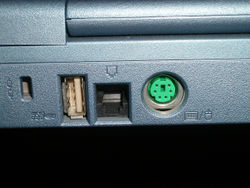PS/2 interface
This article is a stub. You can help Deskthority by expanding it.

The PS/2 interface is a serial keyboard and mouse interface developed by IBM for their PS/2 line of computers. The physical connector is a 6-pin mini-DIN, with four of the pins connected.
Computers generally came with two PS/2 ports, one for the keyboard, and the other for the mouse. The ports were separately marked, as computers required the correct device to be inserted into each socket. Connecting a keyboard into the mouse port, or vice versa, will traditionally not work; an IBM PS/2 computer will hang on boot with a cryptic number displayed on the screen if the keyboard is mistakenly connected to the mouse port. Contrast this with with Apple Desktop Bus, which was a daisy chain bus that accepted devices in any order. Modern laptops however tend to feature a single PS/2 port that can be used by either type of device.
To avoid confusion in identifying the ports, the first version of the PC System Design Guide in 1997 specified that mouse and keyboard ports would be coloured purple and green (specifically, mauve and green) for keyboard and mouse respectively.
PS/2 ports are not hot-swappable, and connecting a keyboard or mouse to a running machine can cause older operating systems to hang.
Keyboard connection
The PS/2 keyboard connection uses the same keyboard protocol as the AT keyboard interface.
For desktop keyboards, the PS/2 interface has a number of advantages over the USB interface:
- PS/2 keyboards send commands directly to the host computer, unlike USB keyboards which must be polled for keypress events.
- Providing that the keyboard circuitry supports it, there is no limit to the number of keys which can be registered simultaneously over PS/2. Standard use of the USB protocol is limited to 6 simultaneous keypresses excluding modifiers ("6KRO"), while PS/2 supports true N-key rollover.
Mouse connection
For mice, IBM introduced a new protocol very similar to the AT interface. This replaced serial mice and older mouse connections.
